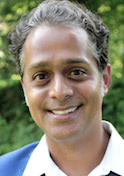- Undergraduate
Bachelor's Degrees
Bachelor of ArtsBachelor of EngineeringPartner School Dual-DegreeUndergraduate AdmissionsUndergraduate Experience
- Graduate
Doctoral Degrees
Doctor of PhilosophyPhD Innovation ProgramDoctor of Medicine-PhDGraduate AdmissionsGraduate Experience
- Research
- Entrepreneurship
- Community
- About
-
All Thayer News
Cell Power
Aug 30, 2017 | Dartmouth Alumni Magazine
On the frontiers of biomedicine with professor Rahul Sarpeshkar
Human brains, like supercomputers, can perform quadrillions of operations per second. But a supercomputer guzzles a lot more energy, enough to power hundreds of houses. A brain, on the other hand, runs on the energy equivalent of an electric shaver.
“Cells are the most energy-efficient computers ever built,” says Rahul Sarpeshkar, an inventor and multifaceted professor—of engineering, physics, microbiology and immunology, and physiology and neurobiology—who arrived at Dartmouth two years ago after working at the Massachusetts Institute of Technology for 16 years. With him came his work on mimicking the way the human body computes.
Sarpeshkar has built low-power and battery-free implants that aid the deaf and paralyzed. He has turned a cell into a calculator. He’s working on an ultra-fast supercomputer that can test drugs virtually and he is figuring out how to reprogram immune cells to fight cancer.
At Dartmouth, Sarpeshkar aims to build a new kind of supercomputer by filling a room or building with millions of his cell-inspired computer chips. Together the chips would simulate the actions of all the cells in an organ, such as a liver, and eventually an entire body. This would allow scientists to test drugs in a computer rather than on patients or animals. “We would be able to google medical cures,” Sarpeshkar says. Though this vision may take 10 years to implement, “it’s not science fiction,” he says. “I’ve laid the foundation already. A lot of the stuff is now way past the risk stage.”
Sarpeshkar showed that he could turn a cell into a calculator by inserting just two proteins to allow the cell to add, subtract, multiply, divide and even take square roots.
Sarpeshkar is also using circuit design principles to repurpose living cells. Genetic engineering has been around for decades, but most examples are simple: Insert one gene into a cell to make a useful protein, such as insulin. Sarpeshkar and others want to insert multiple genes that will work together to accomplish more sophisticated tasks, such as sensing and attacking tumors. “In biology, if you can engineer the cell, you can do anything,” Sarpeshkar says.
Digital thinking has colored much of the work in this area, but complex and bulky digital circuits quickly drain energy. Sarpeshkar believes an analog approach is needed. To prove the point, he showed that he could turn a cell into a calculator by inserting just two proteins—one that ramps up production of a fluorescent molecule and one that dampens levels. This is sufficient to allow the cell to add, subtract, multiply, divide and even take square roots. An equivalent digital solution would take about 130 genetic switches.
Sarpeshkar is collaborating with Edward Usherwood, professor of immunology and microbiology at the Geisel School of Medicine, to reengineer immune cells to fight cancer. One of the most promising new cancer treatments involves taking a patient’s own T cells and genetically engineering them so they can better recognize and kill cancer cells. The therapy has dramatically prolonged survival in some patients with aggressive blood cancers. One major problem, however, is that the cells don’t last long in the body. Sarpeshkar and Usherwood plan to introduce new genetic circuits that improve the cells’ longevity.
Usherwood says that Sarpeshkar has become a “focal point” around which larger collaborations are forming across engineering, computer science, biochemistry and biology at Dartmouth. “Rahul has big, ambitious visions. He wants to build the program at Dartmouth into something that is of international stature,” says Usherwood.
Link to source:
For contacts and other media information visit our Media Resources page.

